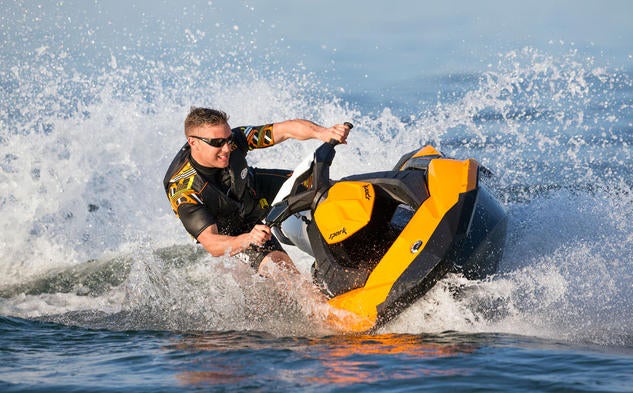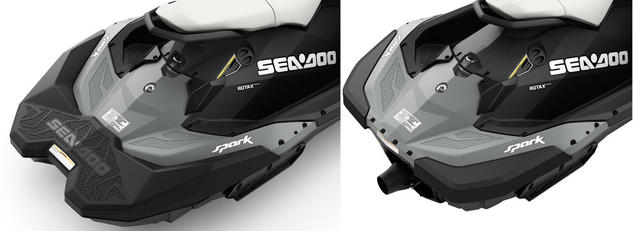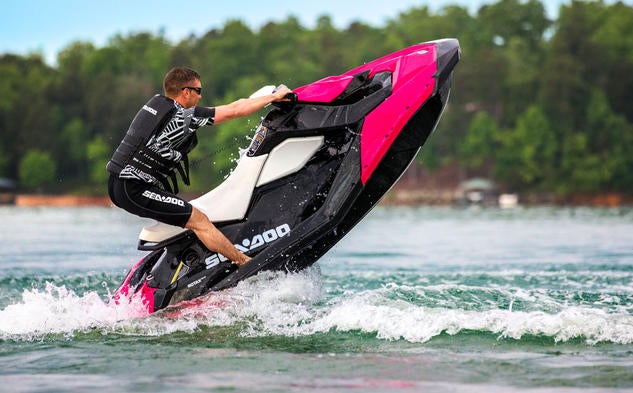2014 Sea-Doo Spark Review
Lightweight craft is fun to toss around
If you’re interested in the Sea-Doo Spark, you’ve likely already read about the craft’s introduction. Long story short, Sea-Doo unveiled the most affordable personal watercraft on the market by thinking completely outside the box in terms of construction and power.
The Spark’s hull and deck are made from lightweight plastic. It features an exoskeleton design that shaves off additional pounds and it’s powered by a lightweight engine that comes in two variations – either 60 or 90 horsepower. Given the craft weighs a mere 405 pounds, the end result is a pretty impressive power-to-weight ratio, and a bottom line price tag ($4,999) that’s literally thousands less than the next closest thing on the market.
 Tipping the scales at just over 400 pounds, BRP is hoping the affordable Sea-Doo Spark will help turn the personal watercraft market around.
Tipping the scales at just over 400 pounds, BRP is hoping the affordable Sea-Doo Spark will help turn the personal watercraft market around.Sea-Doo is obviously thinking Field-of-Dreams here: If you build it, they will come.
BRP Unveils Affordable New 2014 Sea-Doo Spark
While Sea-Doo hopes the Spark will reignite personal watercraft sales, you are probably wondering how the craft handles and what its strengths and weaknesses are. And, most importantly, is the Spark worthy of your dollar.
Split Personality
Let’s start with the ride. If you’re an experienced PWC enthusiast, your first ride on a 60-horsepoer Spark might be a disappointment. I topped out about 42 mph, far slower than I’m accustomed to on anything else on the market. The hull also feels relatively loose compared to the ultra-precise, hard-cornering machines that typify today’s offerings. My suggestion? Give the craft a minute or two. And while you’re at it, try to remember how you used to ride, before watercraft flirted with 70 mph and cornering became so aggressive.
 You won’t get the neck-snapping power of an RXT-X, but that doesn’t stop the Spark from being a fun machine to throw around on the water.
You won’t get the neck-snapping power of an RXT-X, but that doesn’t stop the Spark from being a fun machine to throw around on the water.The Spark put the first grin on my face as I held it full throttle and cranked the bars into a turn, keeping my weight forward and hoping it would slide out old-school style. It did. With a little more practice I was going for power-slide distance, or getting back on the throttle mid-slide and turning those 180s into 360s. At slower speeds, I was also able to lean forward and crank the craft around on its bow or snap a floaty turn off of another craft’s wake. In short, the Spark likes to play in a way many of us have long been forced to forget. And that’s fun. Sometimes, that’s a lot of fun.
That’s not to say it won’t crank a sharp turn when desired. With just a little bit of time on the boat, I learned to put weight on my outside foot and keep the craft locked in through the corners. The technique produces a sharp, aggressive corner, but never overwhelms like more powerful machines can do. It’s a feeling I equated somewhat to the old Yamaha WaveBlaster. In fact, that’s also the way I would describe the craft’s looks. Like a futuristic ‘Blaster.
 Whipping the Spark through a corner is a grin-inducing experience.
Whipping the Spark through a corner is a grin-inducing experience.Still, I’d advise any relatively serious enthusiast to definitely go with the 90-horsepower engine. The added power – which pushes speeds up to 50 mph – just makes the Spark that much more fun. Opting for the bigger engine also gives you the option of Sea-Doo’s familiar Touring and Sport modes. You may never want to leave Sport mode, but the tamer Touring option is nice to have when you’re turning the craft over to younger riders or novices. The 90 is also the far better option should you want to use the Spark for the occasional towsport.
Complete newcomers, or those that just want to have a toy for the kids? That 60 hp version might be all you ever need. But if at all possible, try them first. You can always tone down the 90 when desired; you can’t suddenly add 30 more horses to the 60.
Two vs. Three…And Other Considerations
As to the Spark’s two- and three-passenger options, I’d say while those passenger loads are possible, they’re not always practical. I see the two-up version of the Spark as more of a solo machine, capable of handling the occasional second rider but not nearly as suited to the task as Sea-Doo’s larger offerings. Likewise, I see the three-passenger setup as more of a boat for two, or possibly two adults and a small child on occasion. Of course, that’s a contention I have about most all personal watercraft except for the very biggest models.
 The Spark is available in both a two- and three-seat setup.
The Spark is available in both a two- and three-seat setup.The actual physical difference between the two- and three-passenger versions of the Spark is essentially a longer seat and a bolt-on hull extension. That extension (which adds only 16 pounds to the craft’s overall weight) adds both length and buoyancy, increasing passenger capacity from 350 to 450 pounds. It’s a pretty seamless addition. In fact, the extension blends in so well you may not even notice it without closer inspection.
 An extension is added to the three-seat Spark to accommodate the weight of an extra passenger.
An extension is added to the three-seat Spark to accommodate the weight of an extra passenger.Something else worth addressing on the Spark is reverse. In stock configuration it has none. Instead, it’s like the craft of old, meaning you need to be a little more careful and alert when headed into a dock or beach. Is the available Intelligent Brake & Reverse worth the upgrade price? That depends on you, and how you plan to use the craft. If you’ll be taking the Spark out to a dockside eatery, or frequently navigating busy marinas or waterfronts, that level of control is nice to have. It will alleviate a lot of stress, and possibly even some damage over the years. But in my mind, once you start adding on a lot of these extras the Spark loses a little of its low-cost, simplistic appeal. If you’re confident with your skills, you might want to save the money and put it towards gas.
2013 Kawasaki Jet Ski STX-15F Review
Speaking of potential damage, I’ve already fielded a lot of questions about that plastic hull’s durability. Only some long-term usage will answer the question, but my initial impression of the Spark’s matte-finish plastic is that it seems pretty tough. Fiberglass actually seems far more fragile and susceptible to damage and scratches. One question I have is how those colored panels will fare over long-term exposure to the sun. They pop with color now, but one look at the plastic components on older automobiles makes you wonder how good they’ll look years down the road. I’m sure Sea-Doo has done some testing to make sure they last for a while, but personally I’d invest in a cover…and use it religiously.
Of Lakes And Oceans
One final consideration is just where you’ll use the Spark. Sea-Doo isn’t shy about saying they developed the boat ideally for smaller lakes. Take their advice. A gentler deadrise and the craft’s smaller dimensions likely aren’t the best match for bigger waters. Still, I know some soon-to-be buyers who are already drooling over the craft’s potential jumping ocean surf. Again, if you’re an experienced rider the craft seems to have the goods for freeriding. Newcomers, however, will likely want to stay away from the really rough stuff. The question of whether or not the bolted-together construction and thru-hull engine mounts will also hold up to ocean abuse is also a “only time will tell” situation.
 While BRP is targeting the Spark to small lake riders, it’s light weight would make it a fun machine to launch off of big waves.
While BRP is targeting the Spark to small lake riders, it’s light weight would make it a fun machine to launch off of big waves.In the end, I see the Spark’s customer base dividing along two primary lines. The first is obviously the newcomer to the personal watercraft market. Perhaps they’ve been intrigued by PWC but held back by the price, or maybe that ultra-affordable price convinces them to pick up one or two for their lake house or just to have a new toy to play on. Remember, the goal of the Spark is to “reignite” the industry. That means attract new buyers into the market. At that $4,999 starting price, the Spark certainly has the best chance of any craft in recent memory to do just that.
With its playful personality, however, I’m going to argue the Spark isn’t just for noobs. Many existing enthusiasts will enjoy the craft for its old-school approach, its smaller size, or yes, its “sure-I’ll-try-one” price tag. Proof of that is the fact the aftermarket is already looking at ways to hop it up.
 If the Spark’s five base colors don’t get you excited, BRP is offering a number of wraps to further make the Spark pop on the water.
If the Spark’s five base colors don’t get you excited, BRP is offering a number of wraps to further make the Spark pop on the water.In short, right now this is a craft with a lot of potential, and one that refuses to be pigeonholed. Rich or poor, experienced or novice, don’t sell it short.
| 2014 Sea-Doo Spark Specs | |
| Length | 110 inches (two-passenger)/120 inches (three-passenger) |
| Beam | 46 inches |
| Dry Weight | 405 lbs (two-passenger)/421 lbs (three-passenger) |
| Engine | Three-cylinder four-stroke, normally aspirated |
| Displacement | 899 cc |
| Rated Horsepower | 60/90 |
| Fuel Capacity | 7.9 gal. |
| Combined Stowage Capacity | 0.42 gal (glovebox)/7.42 gal (w/optional front storage bin) |
| Passenger Capacity | 2/350 lbs; 3/450 lbs |
| Colors | Orange Crush, Pineapple, Bubble Gum, Vanilla, Licorice |
| Price | Starting at $4,999 |
Get PersonalWatercraft.com in your Inbox!
Like PersonalWatercraft.com on Facebook
Comments
Most Popular

2025 Yamaha JetBlaster PRO 2-Up Review

2024 Kawasaki Jet Ski STX 160X Review

Remembering the Sea-Doo XP

Whatever Happened to the Wetbike?

2025 Yamaha JetBlaster Review













 Your Privacy Choices
Your Privacy Choices